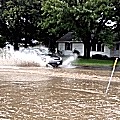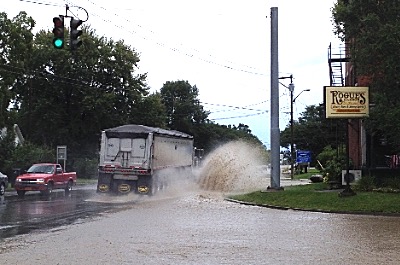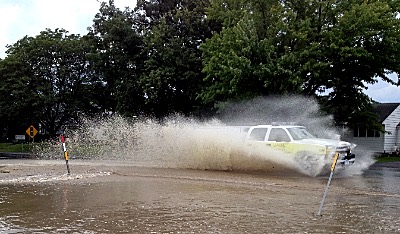- By Dan Veaner
- News
 Print
Print  Lansing Town Engineer David Herrick updated the Town Board Monday on what they can do about flooding in the southern portion of the Town. After severe flooding hit areas of the town two years in a row, Highway Superintendent Jack French says his department receives a couple of calls per week to ask what the Town plans to do about it. Herrick says he has been studying the local watershed and evaluating the capacities of existing infrastructure in an effort to develop solutions the Town Board can choose from.
Lansing Town Engineer David Herrick updated the Town Board Monday on what they can do about flooding in the southern portion of the Town. After severe flooding hit areas of the town two years in a row, Highway Superintendent Jack French says his department receives a couple of calls per week to ask what the Town plans to do about it. Herrick says he has been studying the local watershed and evaluating the capacities of existing infrastructure in an effort to develop solutions the Town Board can choose from."I want to bring the board up to speed on the things that we have done in respect to the awful events of August 2013 and 2014 in the south end of the Town of Lansing," Herrick said. The first step in trying to understand what could be done to mitigate flood damage is to understand first what the problems are, what the watershed is, and how that watershed contributes to the problems in addition to excessive rainfall."
Herrick said that the hydraulic and channel capacities of existing ditches and storm pipes must be studied before coming up with solutions. Ultimately he said the Town Board and Highway Department must choose from options based on budget, effectiveness and the willingness of landowners to allow the Town to intervene.
 Waterwagon Road and Autumn Ridge were not the only areas damaged by flooding. Myers Park was hard hit last August 21, as was Route 34B between East Shore Drive and Triphammer Road.
Waterwagon Road and Autumn Ridge were not the only areas damaged by flooding. Myers Park was hard hit last August 21, as was Route 34B between East Shore Drive and Triphammer Road.Two of the worst hit areas were Waterwagon Road and Autumn Ridge. Herrick outlines some possible solutions for both, but said he would need to study the areas more specifically, including possible on-site visits to measure pipes, channels, swales, culverts, storm sewers, and ditches. He talked about increasing the capacity of the conveyances that exist now.
He said that flood mitigation strategies could also help. That means collecting flood water and storing it temporarily so you can regulate the outflow.
He specifically mentioned a simple mechanical solution to the Waterwagon Road problem. Waterwagon was so violently flooded last summer that the lower end of the road was covered in six inches of water. Four driveway culverts were completely washed out, and others were also damaged.
The solution is essentially a box in which storm water collects. A pipe at the bottom of the box leads to ditches and culverts on the south side of the road, which had the most severe problems in last August's storm. As the southern trenches fill to capacity the water rises in the box and begins to flow into a pipe mounted higher in the box that leads to the ditches on the north side of the road.
 Emergency vehicles were hampered as they responded to flooding emergencies last August.
Emergency vehicles were hampered as they responded to flooding emergencies last August.A similar solution may be retaining ponds that work in a similar way, collecting the water so it can be released into the ditches and culverts at a slower rate so as not to exceed their capacity. A series of such ponds as you go down the hill may make a significant difference in getting the water down to Cayuga Lake without damaging property there.
"It could provide immediate benefits," he said. "You flood it and then let it out slow. But there is a lot of earth work involved, so it is a matter of money."
Herrick was cautious about saying that climate change is responsible for the catastrophic flooding Lansing has suffered. But he said that reacting to the recent incidents of flooding will be a good precaution.
"Everybody says it's going to happen more and more," Herrick said. "You do look at the data and extreme precipitation events are seemingly becoming a greater occurrence."
v11i6


